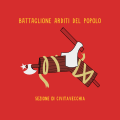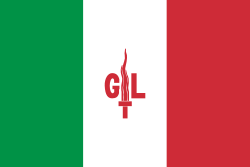Anti-fascism
Anti-fascism is the opposition to fascist ideologies, organizations, governments and people. Anti-fascism started in Europe in the 1920s. At the same time, fascist political parties were getting popular in Europe. Anti-fascism was most popular during and after World War II, when fascist governments were very powerful in Europe. Many different kinds of political parties have believed in anti-fascism. Some of these parties have been Marxist, nationalist, anarchist, socialist, pacifist, social democratic, conservative, and liberal.
Anti-fascism Media
An Italian partisan in Florence, 14 August 1944, during the liberation of Italy
A print depicting Roman armour and accessories including two versions of the fasces (lower right)
Flag of Arditi del Popolo, an axe cutting a fasces. Arditi del Popolo was a militant anti-fascist group founded in 1921 in Italy
1931 badge of a member of Concentrazione Antifascista Italiana
Flag of Giustizia e Libertà, anti-fascist movement active from 1929 to 1945
Bella ciao (instrumental only version performed by the Band of the Guard of the Serbian Armed Forces)







